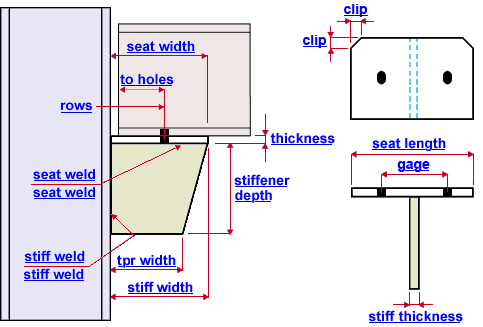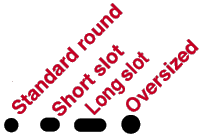"  Seated Plate " connection design locks
Seated Plate " connection design locks
| A plate seat can be applied to a beam that is horizontal or sloping. An optional " Web Stability Angle " or " Top Flange Stability Angle " can be included along with the " |
|
|||
"  |
|
||
Connection Guide: click here , here or here for related screen shots.
End connection failure message: Axial load not applicable to this connection type .
User Defined Connections: Settings that are locked (
) in a user defined connection file will automatically be locked on a member edit window for which that file is the " Input connection type ." You can, if you so choose, manually lock additional settings on the member edit window, and your changes will be retained, through multiple processes, so long as you do not change to a different connection then switch back to the original user defined connection.
Beam Edit: To change a setting, first set it to locked (
). Related settings that are unlocked (
) may be updated, and the "
Left/Right end limit state " calculations will be updated. Settings that are locked (
) will not be changed by connection design , even if doing so might prevent a connection failure.
Connection design locks :
| Locks not dimensioned or called out on the drawing are marked ( not depicted ). |
![]() Seated Plate
Seated Plate
Seat plate
Length ( seat length ): The distance (perpendicular to the work line of the beam) from the near side edge of the seat plate to the far side edge of the seat plate (see example ). The seat plate bolts to the bottom flange of the supported beam. When unlocked (
), the " Length " matches the flange width specified for that beam in the local shape file.
End connection failure message: Seat length less than minimum required
Width ( seat width ): The distance (parallel to the work line of the beam) from the edge of the seat plate that welds to the column to the opposite edge of the seat plate (see example ). The seat plate bolts to the bottom flange of the supported beam.
End connection failure message: Seat width less than minimum required
Plate thickness ( thickness ): The " Material thickness " of the seat plate -- see example . The seat plate bolts to the bottom flange of the supported beam.
Corner clip ( clip ): Corner clips are 45 degree cuts at the two corners of the seat plate edge that frames to the supporting member. You may want to specify corner clips when the beam seat frames to a wide flange column web in order to prevent material clashes between the corners of the plate and the web fillets. A specific distance places the beginning of the corner clip that distance from where the corner would be if it were not cut. ' 0 ' results is square corners (no corner clip).
Bolts in seat plate
Diameter ( not depicted ): The bolt diameter You can either type in any diameter (inches or mm), or you can select a bolt diameter from the combo box (
). The diameters that are listed in the combo box come from Home > Project Settings > Job > Bolt Settings > the " Available bolts " list. The bolt diameter entered here, together with the " Hole type ," set the diameter of holes that bolt the plate seat to the flange of the supported beam.
Hole type ( not depicted ): Standard round or Short slot or Oversized or Long slot or User slot #1 or User slot #2 . The hole type selected here, together with the " Bolt diameter " entered above, set the hole diameter.

Rows: The number of rows of holes ( 0 or 1 or 2 or 3 ) for field bolting the seat plate to the beam. ' 0 ' prevents holes from being designed in the seat plate, presumably because you want the seat to field weld to the beam. ' 1 ' row is shown in the example . If ' 2 ' or ' 3 ' rows are entered, the " Bolt spacing " that is set for the bolt diameter, in Connection Detailing/Fabricator Options , is applied as the row spacing.
Horizontal to holes ( to holes ): The distance (parallel with the work line of the beam) from the end of the beam to the center of the first row of holes in the seat plate (see example ). The seat plate field bolts to the flange of the supported beam. This distance is horizontal if the beam is horizontal.
Gage: The distance (center to center) between the two columns of holes in the seat plate (see example ). The seat plate field bolts to the flange of the supported beam. By default, when the " Gage " is locked and the beam is a wide flange, the bolts align with the flange gage specified for that wide flange in the local shape file.
End connection failure message: Bolt gage not within required min/max values
Stiffener plate
Depth ( stiffener depth ): The distance (parallel with the depth of the beam) between the top and bottom edges of the stiffener plate -- see example . The stiffener plate shop welds to the supporting member and the seat plate.
End connection failure message: Seated connection fails in shear
Width ( stiff width ): The length of the top edge of the stiffener plate (see example ).
Plate thickness ( stiff thickness ): The " Material thickness " of the stiffener plate -- see example . The stiffener plate welds to the column and seat plate.
End connection failure message: Seated connection stiffener fails in buckling
Taper width ( tpr width ): The length of the bottom edge of the stiffener plate (see example ). If the " Taper width ".is less than the " Width " (as in the example ), then the stiffener plate is tapered.
Clip ( not depicted ): The distance (vertical or horizontal) from the corner of the stiffener plate (before it is cut) to where you want the 45 degree cut to begin. Enter ' 0 ' if you do not want the corner clipped.
Welds
Seat ( seat weld ): The weld size for shop welding the stiffener plate to the seat plate (see example ).
Stiffener ( stiff weld ): The weld size for shop welding the edge of the seat plate and stiffener plate to the web/flange of the column (see example ). Note that if you keep this lockable field unlocked and sufficiently lower the stiffener plate " Depth ," the wild size reported here will automatically increase.







